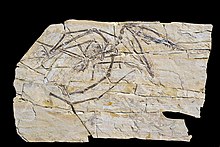Darwinopterus modularis
|
Darwinopterus Temporal range: Middle Jurassic, 160.89–160.25 Ma |
|
|---|---|
 |
|
| D. modularis fossil | |
| Scientific classification | |
| Kingdom: | Animalia |
| Phylum: | Chordata |
| Order: | †Pterosauria |
| Family: | †Wukongopteridae |
| Genus: |
†Darwinopterus Lü et al., 2010 |
| Type species | |
|
Darwinopterus modularis Lü et al., 2010 |
|
| Species | |
|
D. modularis Lü et al., 2010 |
|
D. modularis Lü et al., 2010
D. linglongtaensis Wang et al., 2010
D. robustodens Lü et al., 2011
Darwinopterus (meaning "Darwin's wing") is a genus of pterosaur, discovered in China and named after biologist Charles Darwin. Between 30 and 40 fossil specimens have been identified, all collected from the Tiaojishan Formation, which dates to the middle Jurassic period, 160.89–160.25 Ma ago. The type species, D. modularis, was described in February 2010.D. modularis was the first known pterosaur to display features of both long-tailed ('rhamphorhynchoid') and short-tailed (pterodactyloid) pterosaurs, and was described as a transitional fossil between the two groups. Two additional species, D. linglongtaensis and D. robustodens, were described from the same fossil beds in December 2010 and June 2011, respectively.
Darwinopterus, like its closest relatives, is characterized by its unique combination of basal and derived pterosaurian features. While it had a long tail and other features characteristic of the 'rhamphorhynchoids', it also had distinct pterodactyloid features, such as long vertebrae in the neck and a single skull opening in front of the eyes, the nasoantorbital fenestra (in most 'rhamphorhynchoids', the antorbital fenestra and the nasal opening are separate).
Darwinopterus is distinguished from its close relatives by the greater relative length of the back portion of the skull compared to its jaws, thin nasal bone, and elongated hip bone (illium). The teeth in all species were spaced widely with the longest teeth at the jaw tips. The teeth were spike-like in form, and set into tooth sockets with raised margins. The hand bones were relatively short, even shorter than the femur. The tail was long, with over 20 vertebrae, and was partially stiffened by long, thin bony projections. Unlike other wukongopterids, the head crest found in males was supported by a thin bony extension of the skull, with a serrated top edge. The serrations probably helped anchor an even larger keratin extension.
...
Wikipedia
